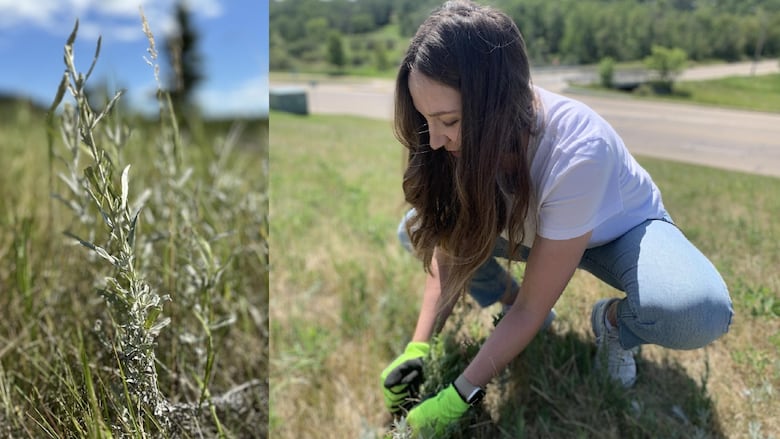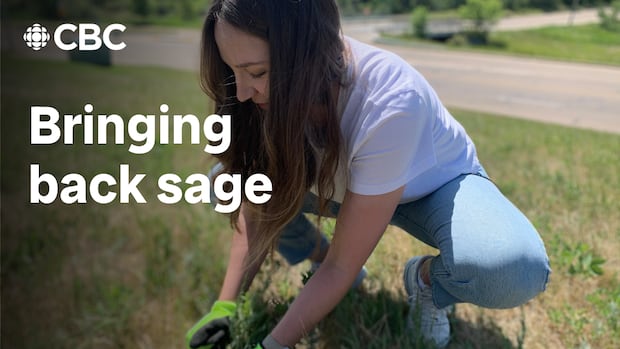Métis prof recruits others to protect native plants after sacred sage mowed down on campus
Plant walk with Indigenous knowledge debuted this spring at University of Alberta's Augustana campus

A field of sage on the University of Alberta's Augustana campus was a place for Indigenous people at the school to harvest the sacred medicine for years. After taking a job at the school in 2022, Willow White thought the space should be protected and its significance should be understood by all.
But this May, after White completed a project promoting a more relational approach to plant life on campus, the field was accidentally mowed down "like it was grass," said Brianna Winiandy-Munch, one of White's research assistants on the project.
"I wouldn't expect everyone to feel the loss… but they should be aware that this was a loss," she said.
But the impact on the community is part of what inspires White to keep working.
White, a citizen of the Métis Nation of Alberta and a descendant of the Inkster, Sutherland, Cook, and Anderson families of the Red River, is an assistant professor who teaches Indigenous studies and English at the campus in Camrose, Alta., 100 kilometres south of Edmonton.
"To most people it probably just looked like some overgrown hill. But it was filled with sage, with prairie sage specifically," White said.
White came up with an idea to protect it back in 2022 after speaking with other Indigenous campus members who were harvesting the sage.
"[We were] anxious that it might get harmed or developed [because] people just don't know how significant and meaningful it is to us," she said.

In addition to sage, trembling aspen, wild rose, yarrow, wolf willow and saskatoon plants also grow at the school.
Eager to protect them all, White applied for a Campus Sustainability Grant to do an educational conservation project — a plant walk. The idea behind it, she said, was to help the community connect with native plants through wahokohtowin.
Wahokohtowin is a Cree word that encompasses the worldview that all beings are connected.
"That was more relational and that could help [community members] see that these are not just weeds and this isn't just land for us to extract from and use," White said.
"We're actually in a deep relationship with this land."

She would end up working with seven knowledge holders, elders and language speakers for guidance, and two research students.
Taylor Soroka, a citizen of the Métis Nation-Saskatchewan (MN-S) entering her third year studying law, crime and justice, was one of the students.
Having studied native plants during an internship with the MN-S, she was already familiar with some of the plant life around Camrose, but on campus she was particularly drawn to the sage and wild roses.
"Even though [wild roses] are a symbol of Alberta, they were where I grew up as well and I saw them every day as a kid," Soroka said.
The plant walk also aligned with what Soroka, who is the Indigenous student representative on campus, said she hoped to achieve in her time at school: help other students get more involved in the outdoors and engaged with nature.
"I find that especially in modern society now, we're so disconnected from the land in general, not only living in cities but just the fact that we can buy everything we need from a drugstore or a regular store," she said.
Students grow on campus
The Augustana plant walk — a 20-30 minute self-guided walk showcasing native plants with informational signs — was ready this spring.
The signs include Cree, Blackfoot and southern Michif names of plants and allow Indigenous students to see themselves and their cultures around them, White said.
"Some Indigenous students come to university with a lot of cultural knowledge. They grew up in community, but many do not and they come to a campus hungry to learn more and hungry to participate in cultural learning and activities," she said.
The plant walk signs include information from knowledge holders about the ways different Indigenous cultures view and use the plants. But White says the experience of the walk is also about learning to see the world around you differently.
Winiandy-Munch, from Saulteau First Nations in Moberly Lake, B.C., was another research student for White, and she was assigned to build a dictionary of Indigenous names of the native plants on campus.
Her work created the basis for what would eventually end up on the signage along the path.
Winiandy-Munch, who recently graduated with a degree in physical education, said she was initially concerned about the fact that she doesn't speak any Indigenous languages. However, White told her that wouldn't be a problem, she said.
Through this project, she learned how to stop seeing plants as mere things.
"An Indigenous way of knowing would be: this is a living being.… And to appreciate those living beings is important," she said.
'A community of care'
But then after three years of protecting and spending time with the plants, the sage field was accidentally mowed down in May.
"It was right before grad," Winiandy-Munch said. She had planned to show it to her family who would be visiting from B.C.
"It was very sad after years and years of advocacy and being in that space," White said.
But White said a friend helped her reframe her grief over the loss of the sage. When she began the project, her goal was to help people develop relationships with the native plants — and it worked.
"It actually wasn't even me who noticed the field had been accidentally mowed," she said.
Multiple colleagues reached out to let her know what had happened, she said, and the Dean's office also spoke about it. The school sent out an apology via email.
"There's a community of care now around the field where three years ago that didn't exist… now this relationship is there and it's beyond me," she said.
For now, White plans to reseed the field with some of the old sage. And when she recently went out to the field to pull up invasive thistle that could outcompete the sage as it regrows, she had nearly 30 helpers including other professors and alumni. Altogether, they managed to fill five big compost bags in about 90 minutes one afternoon.


